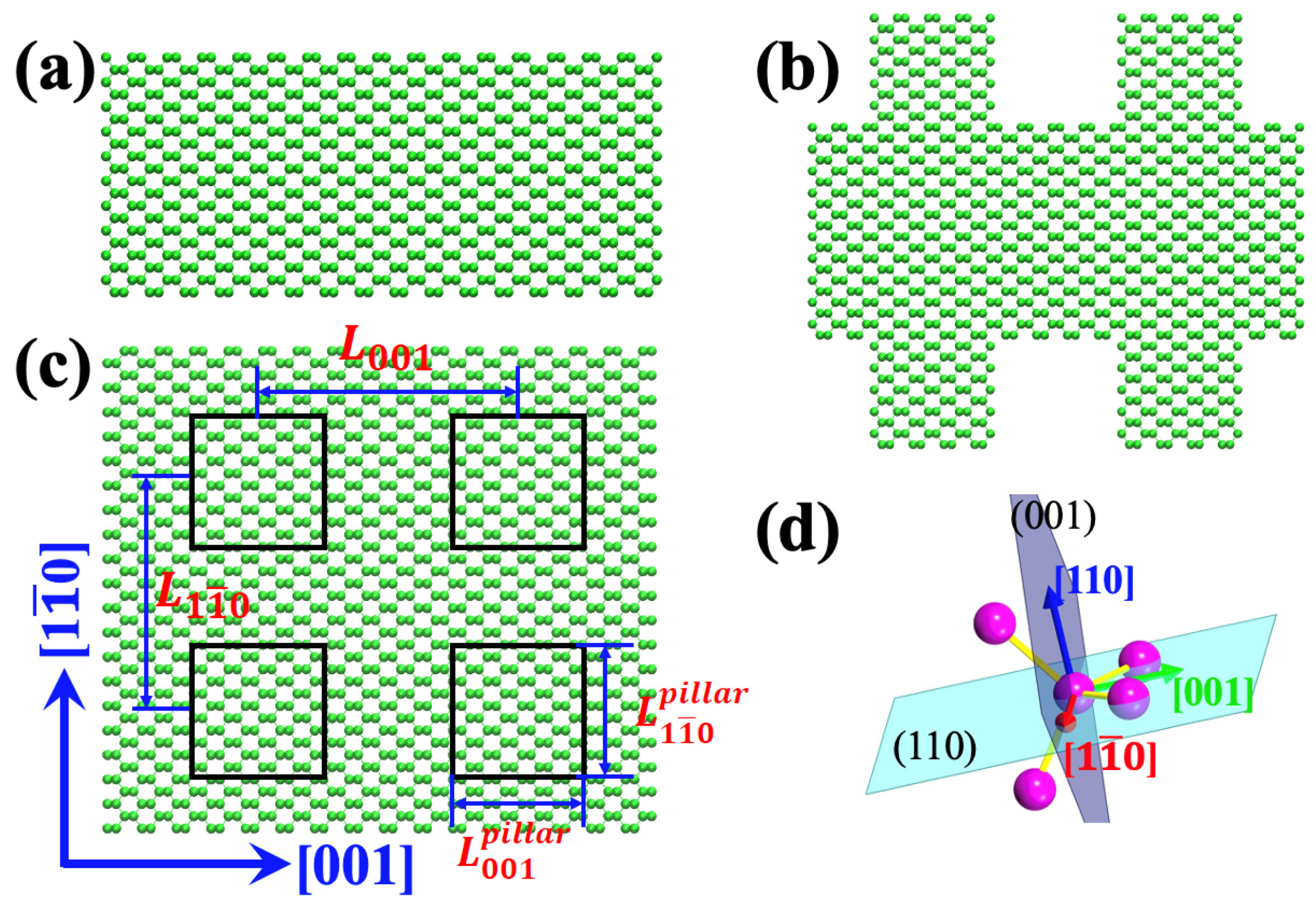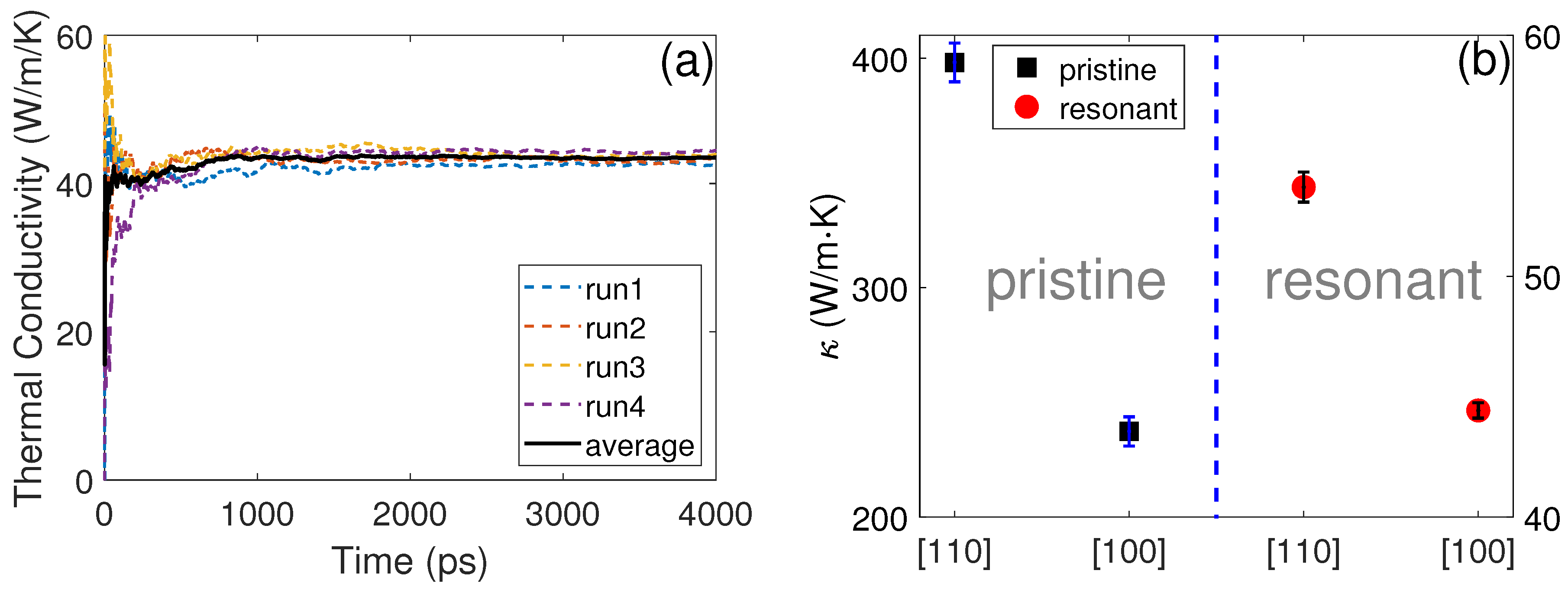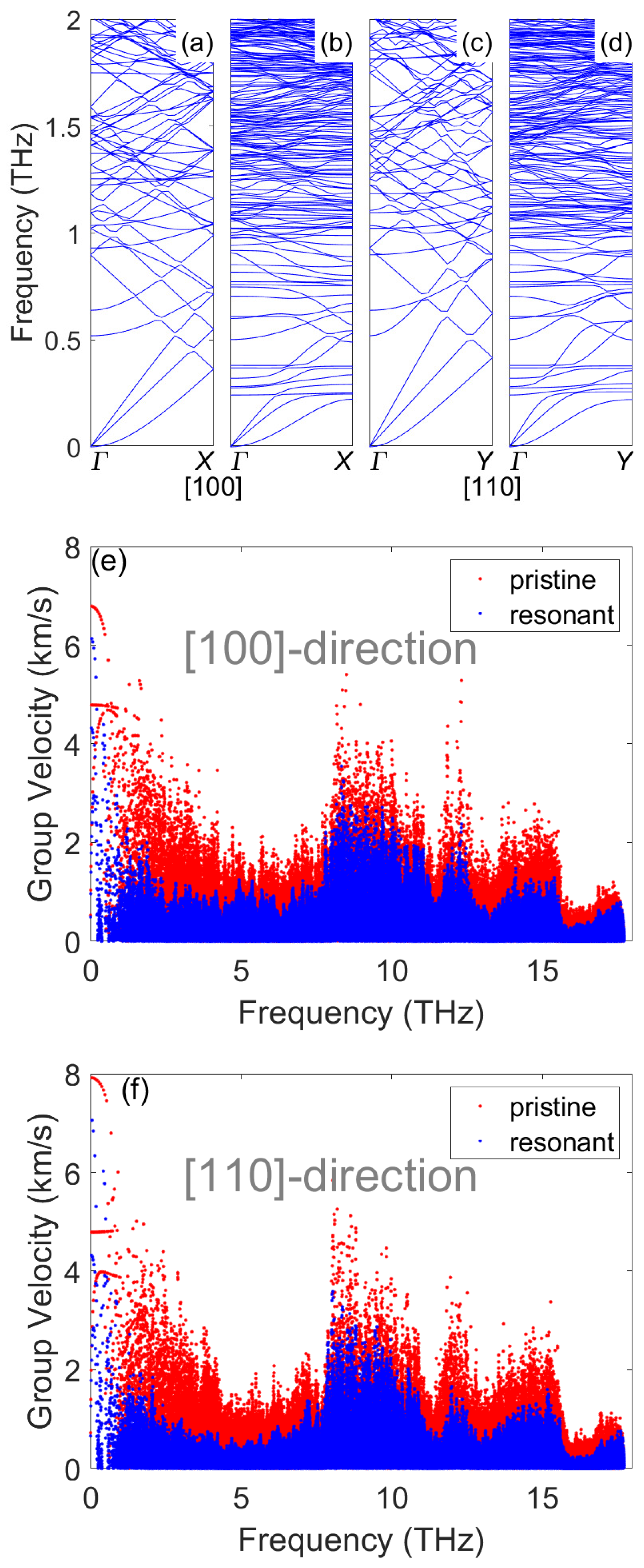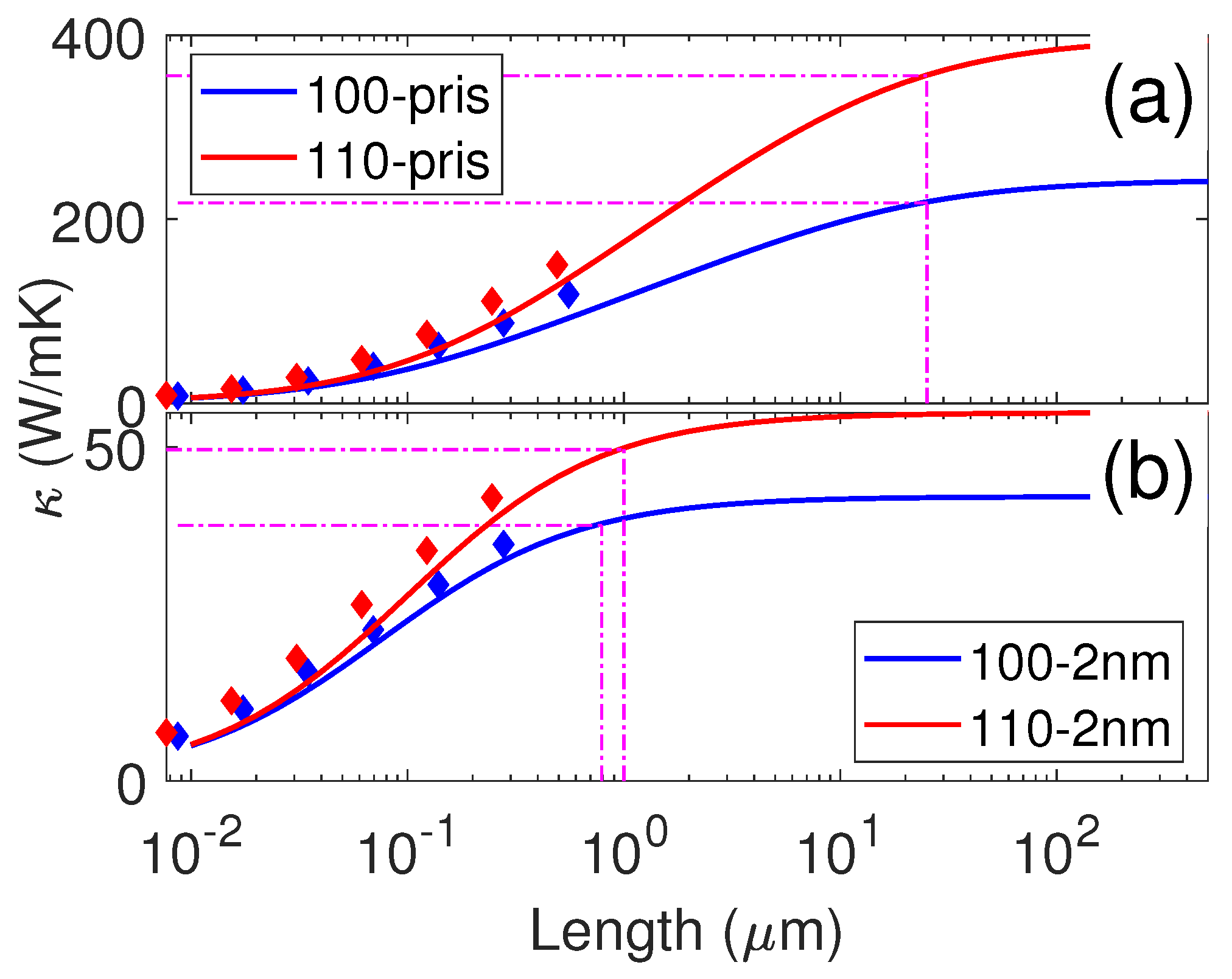Tuning the Anisotropic Thermal Transport in {110}-Silicon Membranes with Surface Resonances
Abstract
:1. Introduction
2. Structures and Methods
3. Results and Discussion
4. Conclusions
Author Contributions
Funding
Institutional Review Board Statement
Informed Consent Statement
Data Availability Statement
Conflicts of Interest
References
- Li, N.; Ren, J.; Wang, L.; Zhang, G.; Hänggi, P.; Li, B. Colloquium: Phononics: Manipulating heat flow with electronic analogs and beyond. Rev. Mod. Phys. 2012, 84, 1045–1066. [Google Scholar] [CrossRef] [Green Version]
- Shi, X.L.; Zou, J.; Chen, Z.G. Advanced Thermoelectric Design: From Materials and Structures to Devices. Chem. Rev. 2020, 120, 7399–7515. [Google Scholar] [CrossRef]
- Wang, L.; Li, B. Thermal Memory: A Storage of Phononic Information. Phys. Rev. Lett. 2008, 101, 267203. [Google Scholar] [CrossRef] [Green Version]
- Bahru, R.; Zamri, M.F.M.A.; Shamsuddin, A.H.; Shaari, N.; Mohamed, M.A. A review of thermal interface material fabrication method toward enhancing heat dissipation. Int. J. Energy Res. 2021, 45, 3548–3568. [Google Scholar] [CrossRef]
- Volz, S.G.; Chen, G. Molecular dynamics simulation of thermal conductivity of silicon nanowires. Appl. Phys. Lett. 1999, 75, 2056–2058. [Google Scholar] [CrossRef]
- Boukai, A.I.; Bunimovich, Y.; Tahir-Kheli, J.; Yu, J.K.; Goddard Iii, W.A.; Heath, J.R. Silicon nanowires as efficient thermoelectric materials. Nature 2008, 451, 168–171. [Google Scholar] [CrossRef] [PubMed]
- Hochbaum, A.I.; Chen, R.; Delgado, R.D.; Liang, W.; Garnett, E.C.; Najarian, M.; Majumdar, A.; Yang, P. Enhanced thermoelectric performance of rough silicon nanowires. Nature 2008, 451, 163–167. [Google Scholar] [CrossRef]
- Fugallo, G.; Cepellotti, A.; Paulatto, L.; Lazzeri, M.; Marzari, N.; Mauri, F. Thermal Conductivity of Graphene and Graphite: Collective Excitations and Mean Free Paths. Nano Lett. 2014, 14, 6109–6114. [Google Scholar] [CrossRef]
- Balandin, A.A. Thermal properties of graphene and nanostructured carbon materials. Nat. Mater. 2011, 10, 569–581. [Google Scholar] [CrossRef] [Green Version]
- He, J.; He, J.; Tritt, T.M. Advances in thermoelectric materials research: Looking back and moving forward. Science 2017, 357. [Google Scholar] [CrossRef] [Green Version]
- Hussein, M.I.; Tsai, C.N.; Honarvar, H. Thermal Conductivity Reduction in a Nanophononic Metamaterial versus a Nanophononic Crystal: A Review and Comparative Analysis. Adv. Funct. Mater. 2020, 30, 1906718. [Google Scholar] [CrossRef]
- Davis, B.L.; Hussein, M.I. Nanophononic Metamaterial: Thermal Conductivity Reduction by Local Resonance. Phys. Rev. Lett. 2014, 112, 055505. [Google Scholar] [CrossRef] [Green Version]
- Wang, H.; Cheng, Y.; Nomura, M.; Volz, S.; Donadio, D.; Zhang, X.; Xiong, S. Synergistic impeding of phonon transport through resonances and screw dislocations. Phys. Rev. B 2021, 103, 085414. [Google Scholar] [CrossRef]
- Xiong, S.; Sääskilahti, K.; Kosevich, Y.A.; Han, H.; Donadio, D.; Volz, S. Blocking Phonon Transport by Structural Resonances in Alloy-Based Nanophononic Metamaterials Leads to Ultralow Thermal Conductivity. Phys. Rev. Lett. 2016, 117, 025503. [Google Scholar] [CrossRef]
- Chen, J.; Zhang, G.; Li, B. Phonon coherent resonance and its effect on thermal transport in core-shell nanowires. J. Chem. Phys. 2011, 135, 104508. [Google Scholar] [CrossRef] [Green Version]
- Ma, D.; Wan, X.; Yang, N. Unexpected thermal conductivity enhancement in pillared graphene nanoribbon with isotopic resonance. Phys. Rev. B 2018, 98, 245420. [Google Scholar] [CrossRef] [Green Version]
- Neogi, S.; Reparaz, J.S.; Pereira, L.F.C.; Graczykowski, B.; Wagner, M.R.; Sledzinska, M.; Shchepetov, A.; Prunnila, M.; Ahopelto, J.; Sotomayor-Torres, C.M.; et al. Tuning thermal transport in ultrathin silicon membranes by surface nanoscale engineering. ACS Nano 2015, 9, 3820–3828. [Google Scholar] [CrossRef] [Green Version]
- Neogi, S.; Donadio, D. Anisotropic In-Plane Phonon Transport in Silicon Membranes Guided by Nanoscale Surface Resonators. Phys. Rev. Appl. 2020, 14, 024004. [Google Scholar] [CrossRef]
- Ma, D.; Ding, H.; Meng, H.; Feng, L.; Wu, Y.; Shiomi, J.; Yang, N. Nano-cross-junction effect on phonon transport in silicon nanowire cages. Phys. Rev. B 2016, 94, 165434. [Google Scholar] [CrossRef] [Green Version]
- Ma, D.; Arora, A.; Deng, S.; Xie, G.; Shiomi, J.; Yang, N. Quantifying phonon particle and wave transport in silicon nanophononic metamaterial with cross junction. Mater. Today Phys. 2019, 8, 56–61. [Google Scholar] [CrossRef]
- Giri, A.; Hopkins, P.E. Resonant phonon modes in fullerene functionalized graphene lead to large tunability of thermal conductivity without impacting the mechanical properties. J. Appl. Phys. 2019, 125, 205102. [Google Scholar] [CrossRef]
- Wan, Y.; Xiong, S.; Ouyang, B.; Niu, Z.; Ni, Y.; Zhao, Y.; Zhang, X. Thermal transport engineering in graphdiyne and graphdiyne nanoribbons. ACS Omega 2019, 4, 4147–4152. [Google Scholar] [CrossRef]
- Li, W.; Mingo, N. Ultralow lattice thermal conductivity of the fully filled skutterudite YbFe4Sb12 due to the flat avoided-crossing filler modes. Phys. Rev. B 2015, 91, 144304. [Google Scholar] [CrossRef]
- Li, W.; Carrete, J.; Madsen, G.K.H.; Mingo, N. Influence of the optical-acoustic phonon hybridization on phonon scattering and thermal conductivity. Phys. Rev. B 2016, 93, 205203. [Google Scholar] [CrossRef]
- Tadano, T.; Gohda, Y.; Tsuneyuki, S. Impact of Rattlers on Thermal Conductivity of a Thermoelectric Clathrate: A First-Principles Study. Phys. Rev. Lett. 2015, 114, 095501. [Google Scholar] [CrossRef] [Green Version]
- Zhang, Z.; Hu, S.; Nakayama, T.; Chen, J.; Li, B. Reducing lattice thermal conductivity in schwarzites via engineering the hybridized phonon modes. Carbon 2018, 139, 289–298. [Google Scholar] [CrossRef]
- Xiong, S.; Selli, D.; Neogi, S.; Donadio, D. Native surface oxide turns alloyed silicon membranes into nanophononic metamaterials with ultralow thermal conductivity. Phys. Rev. B 2017, 95, 180301. [Google Scholar] [CrossRef] [Green Version]
- Wan, X.; Ma, D.; Pan, D.; Yang, L.; Yang, N. Optimizing thermal transport in graphene nanoribbon based on phonon resonance hybridization. Mater. Today Phys. 2021, 20, 100445. [Google Scholar] [CrossRef]
- Wang, H.; Cheng, Y.; Fan, Z.; Guo, Y.; Zhang, Z.; Bescond, M.; Nomura, M.; Ala-Nissila, T.; Volz, S.; Xiong, S. Anomalous thermal conductivity enhancement in low dimensional resonant nanostructures due to imperfections. Nanoscale 2021, 13, 10010–10015. [Google Scholar] [CrossRef]
- Evans, D.J. Homogeneous NEMD algorithm for thermal conductivity application of non-canonical linear response theory. Phys. Lett. A 1982, 91, 457–460. [Google Scholar] [CrossRef]
- Fan, Z.; Dong, H.; Harju, A.; Ala-Nissila, T. Homogeneous nonequilibrium molecular dynamics method for heat transport and spectral decomposition with many-body potentials. Phys. Rev. B 2019, 99, 064308. [Google Scholar] [CrossRef] [Green Version]
- Fan, Z.; Chen, W.; Vierimaa, V.; Harju, A. Efficient molecular dynamics simulations with many-body potentials on graphics processing units. Comput. Phys. Commun. 2017, 218, 10–16. [Google Scholar] [CrossRef] [Green Version]
- Stillinger, F.H.; Weber, T.A. Computer simulation of local order in condensed phases of silicon. Phys. Rev. B 1985, 31, 5262–5271. [Google Scholar] [CrossRef] [Green Version]
- Sääskilahti, K.; Oksanen, J.; Tulkki, J.; Volz, S. Role of anharmonic phonon scattering in the spectrally decomposed thermal conductance at planar interfaces. Phys. Rev. B 2014, 90, 134312. [Google Scholar] [CrossRef] [Green Version]
- Sääskilahti, K.; Oksanen, J.; Volz, S.; Tulkki, J. Frequency-dependent phonon mean free path in carbon nanotubes from nonequilibrium molecular dynamics. Phys. Rev. B 2015, 91, 115426. [Google Scholar] [CrossRef] [Green Version]
- Fan, Z.; Pereira, L.F.C.; Hirvonen, P.; Ervasti, M.M.; Elder, K.R.; Donadio, D.; Ala-Nissila, T.; Harju, A. Thermal conductivity decomposition in two-dimensional materials: Application to graphene. Phys. Rev. B 2017, 95, 144309. [Google Scholar] [CrossRef] [Green Version]
- Gabourie, A.J.; Fan, Z.; Ala-Nissila, T.; Pop, E. Spectral decomposition of thermal conductivity: Comparing velocity decomposition methods in homogeneous molecular dynamics simulations. Phys. Rev. B 2021, 103, 205421. [Google Scholar] [CrossRef]
- Li, Z.; Xiong, S.; Sievers, C.; Hu, Y.; Fan, Z.; Wei, N.; Bao, H.; Chen, S.; Donadio, D.; Ala-Nissila, T. Influence of thermostatting on nonequilibrium molecular dynamics simulations of heat conduction in solids. J. Chem. Phys. 2019, 151, 234105. [Google Scholar] [CrossRef] [Green Version]
- Zhang, W.; Fisher, T.S.; Mingo, N. The Atomistic Green’s Function Method: An Efficient Simulation Approach for Nanoscale Phonon Transport. Numer. Heat Transf. Part B Fundam. 2007, 51, 333–349. [Google Scholar] [CrossRef]
- Mandadapu, K.K.; Jones, R.E.; Papadopoulos, P. A homogeneous nonequilibrium molecular dynamics method for calculating the heat transport coefficient of mixtures and alloys. J. Chem. Phys. 2010, 133, 034122. [Google Scholar] [CrossRef]
- Li, K.; Cheng, Y.; Wang, H.; Guo, Y.; Zhang, Z.; Bescond, M.; Nomura, M.; Volz, S.; Zhang, X.; Xiong, S. Phonon resonant effect in silicon membranes with different crystallographic orientations. Int. J. Heat Mass Transf. 2021, 183, 122144. [Google Scholar] [CrossRef]
- Gale, J.D.; Rohl, A.L. The General Utility Lattice Program (GULP). Mol. Simul. 2003, 29, 291–341. [Google Scholar] [CrossRef]
- Dong, H.; Fan, Z.; Shi, L.; Harju, A.; Ala-Nissila, T. Equivalence of the equilibrium and the nonequilibrium molecular dynamics methods for thermal conductivity calculations: From bulk to nanowire silicon. Phys. Rev. B 2018, 97, 094305. [Google Scholar] [CrossRef] [Green Version]





Publisher’s Note: MDPI stays neutral with regard to jurisdictional claims in published maps and institutional affiliations. |
© 2021 by the authors. Licensee MDPI, Basel, Switzerland. This article is an open access article distributed under the terms and conditions of the Creative Commons Attribution (CC BY) license (https://creativecommons.org/licenses/by/4.0/).
Share and Cite
Li, K.; Cheng, Y.; Dou, M.; Zeng, W.; Volz, S.; Xiong, S. Tuning the Anisotropic Thermal Transport in {110}-Silicon Membranes with Surface Resonances. Nanomaterials 2022, 12, 123. https://doi.org/10.3390/nano12010123
Li K, Cheng Y, Dou M, Zeng W, Volz S, Xiong S. Tuning the Anisotropic Thermal Transport in {110}-Silicon Membranes with Surface Resonances. Nanomaterials. 2022; 12(1):123. https://doi.org/10.3390/nano12010123
Chicago/Turabian StyleLi, Keqiang, Yajuan Cheng, Maofeng Dou, Wang Zeng, Sebastian Volz, and Shiyun Xiong. 2022. "Tuning the Anisotropic Thermal Transport in {110}-Silicon Membranes with Surface Resonances" Nanomaterials 12, no. 1: 123. https://doi.org/10.3390/nano12010123
APA StyleLi, K., Cheng, Y., Dou, M., Zeng, W., Volz, S., & Xiong, S. (2022). Tuning the Anisotropic Thermal Transport in {110}-Silicon Membranes with Surface Resonances. Nanomaterials, 12(1), 123. https://doi.org/10.3390/nano12010123





